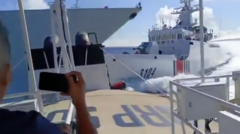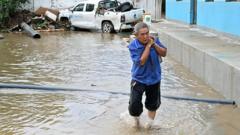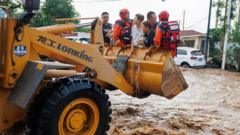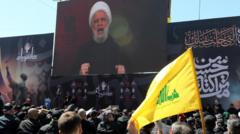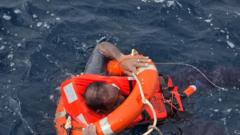The ongoing territorial dispute between China and the Philippines intensifies as Beijing asserts control over a small sandbank in the Spratly Islands, provoking a strong response from Manila and drawing concerns from the U.S.
Tension Escalates in South China Sea as Beijing Seizes Disputed Sandbank
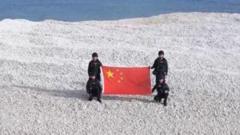
Tension Escalates in South China Sea as Beijing Seizes Disputed Sandbank
Chinese coastguard's assertion of control sparks regional conflict with Philippines
The Chinese coastguard has reportedly taken control of a small sandbank, known as Sandy Cay, in the contested South China Sea, according to state media. The move has raised alarms over the already tense territorial disputes between China and the Philippines. State broadcaster CCTV published images showing coastguard officers on the sandbank, dressed in all black and displaying the Chinese flag, as they declared their "maritime control" over the region.
In response to this action, the Philippines announced that its forces had also landed on three sandbanks, accompanying their display of national pride by mimicking the Chinese gesture with their own flag. The National Task Force West Philippine Sea (NTF-WPS) issued a statement pointing out the "illegal presence" of multiple Chinese vessels nearby, emphasizing the Philippine government's determination to assert its sovereignty in the West Philippine Sea amidst increasing tensions.
The situation around Sandy Cay, which is in proximity to a Philippine military outpost on Thitu Island, has been exacerbated by frequent confrontations and territorial skirmishes, with historical claims complicating the scenario. Although there is currently no indication that China is establishing a permanent presence on the sandbank, the prospect has sparked concerns from the White House, which labeled the actions as "deeply concerning." National Security Council spokesperson James Hewitt noted that such moves threaten regional stability and contravene international law.
The escalation coincides with joint military exercises—termed Balikatan—between U.S. and Philippine forces, involving 17,000 personnel. The U.S. has conducted missile tests off the coast of the Philippines during these drills, reinforcing its commitment to regional partnerships. CBS reports indicate that these military exercises are essential for national defense and are not directed at any specific country, despite ongoing tensions.
Historically marked by territorial disputes, the South China Sea has seen competing claims from several nations, including Vietnam, Malaysia, and Brunei, which further complicate matters. China's expansive claims, drawn from its "nine-dash line," have been reinforced by aggressive island-building efforts and naval patrols, setting the stage for potential clashes in the strategically significant area.
In response to this action, the Philippines announced that its forces had also landed on three sandbanks, accompanying their display of national pride by mimicking the Chinese gesture with their own flag. The National Task Force West Philippine Sea (NTF-WPS) issued a statement pointing out the "illegal presence" of multiple Chinese vessels nearby, emphasizing the Philippine government's determination to assert its sovereignty in the West Philippine Sea amidst increasing tensions.
The situation around Sandy Cay, which is in proximity to a Philippine military outpost on Thitu Island, has been exacerbated by frequent confrontations and territorial skirmishes, with historical claims complicating the scenario. Although there is currently no indication that China is establishing a permanent presence on the sandbank, the prospect has sparked concerns from the White House, which labeled the actions as "deeply concerning." National Security Council spokesperson James Hewitt noted that such moves threaten regional stability and contravene international law.
The escalation coincides with joint military exercises—termed Balikatan—between U.S. and Philippine forces, involving 17,000 personnel. The U.S. has conducted missile tests off the coast of the Philippines during these drills, reinforcing its commitment to regional partnerships. CBS reports indicate that these military exercises are essential for national defense and are not directed at any specific country, despite ongoing tensions.
Historically marked by territorial disputes, the South China Sea has seen competing claims from several nations, including Vietnam, Malaysia, and Brunei, which further complicate matters. China's expansive claims, drawn from its "nine-dash line," have been reinforced by aggressive island-building efforts and naval patrols, setting the stage for potential clashes in the strategically significant area.


